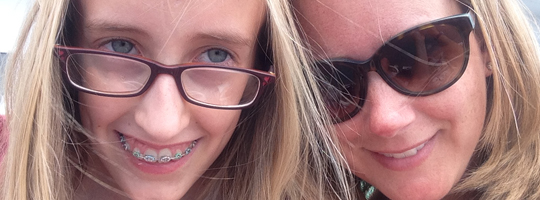
My daughter, Emma, just started 6th grade – middle school in our district. Like a lot of parents in my town, I watched her get on the bus, looking more grown up than ever, and then stood there for a moment, wondering, “How did THAT happen? Didn’t I just get her to give up her pacifier?”
Unlike the other parents in town, though, I had a few extra concerns about starting a new school because Emma has Marfan syndrome. And that meant I’d have to have to educate a whole new crop of teachers about a condition they most likely had never heard of.
We’d been lucky enough so far. We had a wonderful school nurse in elementary school and many caring teachers. But, in truth, Emma didn’t need too many accommodations in the younger grades. At the beginning of the year, I’d write a quick letter to her teachers explaining what Marfan syndrome is, and I’d go over the list of “safe” and “unsafe” activities. She had some accommodations through a 504 Plan and I was pleased. Things hummed along.
Then Emma grew. She started wearing a back brace at 8. She began having more trouble seeing the board, even with glasses. She started getting regular headaches and occasional migraines. She was easily exhausted. Gym became especially stressful and frustrating because it wasn’t always clear to her and to others what she could and could not do.
Now, at 12, not only was she facing the regular challenges of adolescence and middle school, but also a changing cardiac and orthopedic picture – and gym five days a week. This, I thought, couldn’t possibly be good. Gym had to go.
I set up a meeting with the nurse and the gym teacher in June. To prepare, I browsed The Marfan Foundation’s website and found the resources for school nurses and teachers. They were just what I needed – thorough and reader-friendly. I printed them out, then flagged and highlighted the most important points. Then, the first week of school, I shared the information with Emma’s subject teachers, and told them how her condition might impact her in class – which, as it turns out, wasn’t necessary because the nurse had already made a similar packet for each of them!
To say the response has been positive is an understatement. The materials definitely opened up a dialogue, facilitated conversations I was eager to have, and set the stage for a really good partnership. Of course, the responsibility is not entirely the school’s — Emma has to be proactive and self-advocate, too. And she’s learning. Last year, a substitute teacher refused to let her leave the room when she was having painful symptoms of what could have been a pneumothorax: She left anyway. To me, it was the most valuable lesson she learned all year.
Right now, the middle school staff is still getting to know Emma, just as they’re getting to know all their new students. Maybe they’re being a little overprotective of her, but that’s OK. They’ll figure it out. And so will we. How do I know this? Because after being so sure I needed to pull her out of gym forever, my instincts after our meeting said, “Wait. They’re listening. This could work.” And good thing I did, because otherwise this exchange wouldn’t have happened a few days ago:
Me: How was school today?
Emma: Awesome! Did I tell you how much I love gym? I think it might be my favorite class.
Me: Wow! I never expected to hear those words from you.
Emma: I know! But Mr. L finds all these fun ways to include me, even when I’m not actually playing, and I always feel so important. He gets it, Mom. So far, everyone gets it.
And now so do I. When people know better, they can do better. Sometimes they just need someone to teach them. For my daughter, and for all those who’ll come after her, I’m happy to raise my hand.
Join our Adopt-A-School Victory Challenge today and educate the school nurses and teachers in your area. Informing school personnel helps your child achieve his or her best in school and raises awareness so that others may be diagnosed.

Jennifer Lynch lives in New Jersey and is the mother of Emma, 12, who was diagnosed with Marfan syndrome at 5 months old, and an unaffected son, Andrew, 8.
